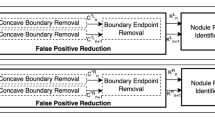Abstract
Considering that the traditional lung segmentation algorithms are not adaptive for the situations that most of the juxtapleural nodules, which are excluded as fat, and lung are not segmented perfectly. In this paper, several methods are comprehensively utilized including optimal iterative threshold, three-dimensional connectivity labeling, three-dimensional region growing for the initial segmentation of the lung parenchyma, based on improved chain code, and Bresenham algorithms to repair the lung parenchyma. The paper thus proposes a fully automatic method for lung parenchyma segmentation and repairing. Ninety-seven lung nodule thoracic computed tomography scans and 25 juxtapleural nodule scans are used to test the proposed method and compare with the most-cited rolling-ball method. Experimental results show that the algorithm can segment lung parenchyma region automatically and accurately. The sensitivity of juxtapleural nodule inclusion is 100 %, the segmentation accuracy of juxtapleural nodule regions is 98.6 %, segmentation accuracy of lung parenchyma is more than 95.2 %, and the average segmentation time is 0.67 s/frame. The algorithm can achieve good results for lung parenchyma segmentation and repairing in various cases that nodules/tumors adhere to lung wall.

















Similar content being viewed by others
References
Rubin GD, Lyo JK, Paik DS, et al: Pulmonary nodules on multi-detector row CT scans: performance comparison of radiologists and computer-aided detection. Radiology 234(10):274–283, 2005
Bram VG, Bart MH, Max A: Computer-aided diagnosis in chest radiography. IEEE Trans Med Imaging 20(12):1228–1241, 2001
Lin DT, Yan CR, Chen WT: Autonomous detection of pulmonary nodules on CT image with a neural network-based fuzzy system. Comput Med Imag Graph 29(6):447–458, 2005
Qiang L: Recent progress in computer-aided diagnosis of lung nodules on thin-section CT. Comput Med Imag Graph 31(3):248–257, 2007
Lee Y, Hara T, Fujita H, et al: Automated detection of pulmonary nodules in helical ct images based on an improved template-matching technique. IEEE Trans Med Imag 20(7):595–604, 2001
Farag A., El-Baz A., Gimelfarb G. G., Falk R., Hushek S. G. (2004) Automatic detection and recognition of lung abnormalities in helical CT images using deformable templates. Lecture Notes in Computer Science, Medical Image Computing and Computer-Assisted Intervention, 3217. Springer, New York, pp. 856–864
Hu S, Hoffman EA, Joseph MR: Automatic pulmonary segmentation for accurate quantitation of volumetric X-ray CT images. IEEE Trans Med Imag 20(6):490–498, 2001
Bian XY, Wu Y: A method of careful lung segmentation based on CT images. Journal of Chongqing University of Posts and Telecommunications (Natural Science Edition) 22(5):665–668, 2010
Armato III, SG, Giger ML, Moran CJ, et al: Computerized detection of pulmonary nodules on CT scan. RadioGraphics 19(5):1303–1311, 2000
Cuevas LM, Spieth PM, Carvalho AR, et al: Automatic lung segmentation of helical CT scans in experimental induced lung injury. IFMBE Proceedings 22:764–767, 2008
Guo SW, Zeng QS, Chen J: Extraction of pulmonary parenchyma in thoracic CT and computer aided diagnosis. Chin J Biomed Eng 27(5):788–791, 2008. in Chinese
Pu JT, Justus R, Chin A, et al: Adaptive border marching algorithm: automatic lung segmentation on chest CT images. Comput Med Imag Graph 32:452–462, 2008
Yuan KH, Xiang LX: Automated lung segmentation for chest CT images used for computer aided diagnostics. Journal of Tsinghua University 51(1):90–95, 2011. in Chinese
Zhou YY, Feng HQ, Li CF: Automated lung segmentation in serial thoracic high resolution CT images. Beijing Biomedical Engineering 27(1):6–10, 2008. in Chinese
Giorgio DN, Eleonora T, Antonella A, et al: Automatic lung segmentation in CT images with accurate handling of the hilar region. J Digit Imag 24(1):11–27, 2011
Leader JK, Zheng B, Rogers RM: Automated lung segmentation in X-ray computed tomography: development and evaluation of a heuristic threshold-based scheme. Acad Radiol 10(11):1224–1236, 2003
Hedlund LW, Anderson RF, Goulding PL: Two methods for isolating the lung area of a CT scan for density information. Radiology 144(2):353–357, 1982
Armato III, SG, Sensakovic WF: Automated lung segmentation for thoracic CT impact on computer-aided diagnosis. Acad Radiol 11(9):1011–1021, 2004
McNitt-Grag MF, Sayre JW, Huang HK, et al: Pattern classification approach to segmentation of digital chest radiographs and chest CT image slices. Proc SPIE 2167:465–476, 1994
Bai SL, Ying DJ: The anatomy. People’s Health Publishing House, Beijing, 2006. in Chinese
Gonzalez RC, Richard EW, Steven LE (2004) Digital image processing using MATLAB[M]. Pearson Education, Inc., publishing as Prentice Hall, Englewood Cliffs
Lu ZQ, Tong T: The application of chain code sum in the edge form analysis [J]. Int J Image Graph 7(12):1323–1328, 2002. in Chinese
Tan JH, Zhang J: Identifying for the convex–concave of peripherals based on chain code difference. Science Technology and Engineering 7(5):769–772, 2007. in Chinese
Tang ZS: Computer graphics algorithms. Tsinghua University Publishing House, Beijing, 1995. in Chinese
Acknowledgments
This work is supported by the National Nature Science Foundation of China (grant no. 60671050) and Ministry of Higher Education through Fundamental Research Grant Scheme for the Central Universities (grant no. N100404010).
Author information
Authors and Affiliations
Corresponding author
Rights and permissions
About this article
Cite this article
Wei, Y., Shen, G. & Li, Jj. A Fully Automatic Method for Lung Parenchyma Segmentation and Repairing. J Digit Imaging 26, 483–495 (2013). https://doi.org/10.1007/s10278-012-9528-9
Published:
Issue Date:
DOI: https://doi.org/10.1007/s10278-012-9528-9




